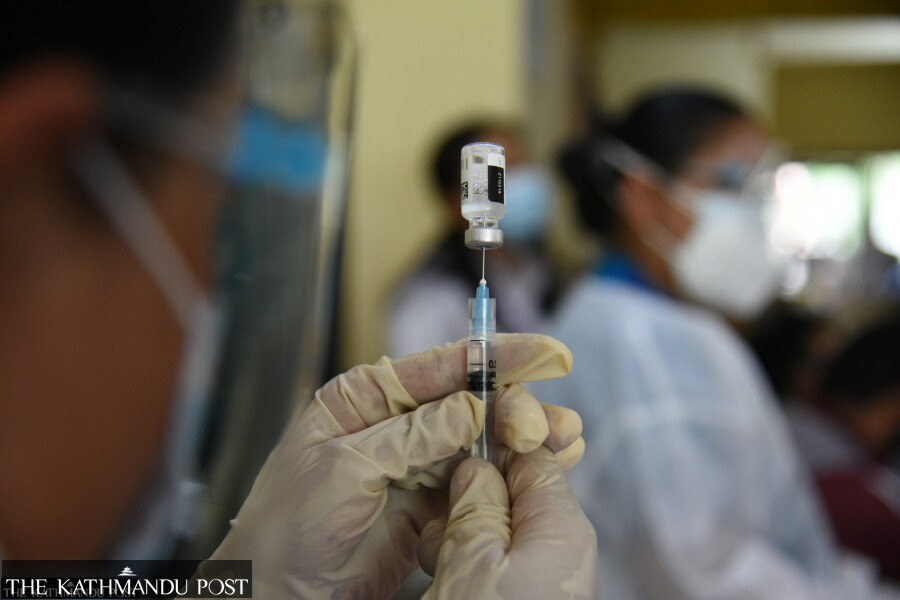Health
Hospitals in Kathmandu fined for not carrying out autoclaving of used syringe needles
The environment department of the Kathmandu Metropolitan City has fined three private hospitals for mixing hospital waste with household garbage.
Post Report
Some private hospitals in Kathmandu Valley have not even been carrying out autoclaving of used syringe needles and hazardous medical wastes, a random inspection by the environment department of the Kathmandu Metropolitan City shows.
Autoclaving is a steam sterilisation process that medical facilities use to disinfect small equipment, tools or medical waste, so that it can be disposed of safely.
“We have fined three private hospitals in the current fiscal year for ignoring our instruction to manage the hazardous waste safely,” said Shristi Shrestha, an environment inspector at the department.
Experts say hospital waste management is an important but neglected issue in Kathmandu. Officials said that along with private health facilities—hospitals, nursing homes, polyclinics, laboratories—state-run health facilities also discard hazardous medical wastes mixed up with household wastes.
Shrestha said that the department fined Rs100,000 each to the Kalanki-based Nepal National Hospital and the Teku-based Buddha Mai Hospital, and Rs50,000 to the Baneshwar-based Everest Hospital.
“We had warned the private hospitals to manage hazardous medical wastes properly and given some instructions to follow,” said Shrestha. “But those hospitals neither took the warning seriously nor followed the instructions.”
Many health facilities including state-run hospitals do not have waste disposal equipment. Doctors say mixing hospital and household wastes poses a serious threat of spreading infections—HIV, Hepatitis B, Hepatitis C, tuberculosis, tetanus, and coronavirus—to those handling the waste.
Not only the municipal cleaning staff but also ragpickers get injured and infected by the needles used in the health facilities.
“Some hospitals could not show autoclave machines, and some were found not to be providing personal protective equipment to the staff hired for waste segregation,” said Shrestha. “Hazardous medical waste is being transported to various locations for sorting out recyclable materials and ultimately discarded at the dumping site.”
There are an estimated over 2,100 health facilities—hospitals, nursing homes, polyclinics, and laboratories in operation in the Kathmandu metropolitan area alone. Officials said that the majority of such health facilities lack even the permission to operate. Moreover, the operating licences of most hospitals have long expired, according to officials.
KMC officials said that almost all private health facilities have been discarding hazardous medical wastes mixing them up with household garbage. According to them, some also burn such waste in the open, which is harmful for the environment.
Experts say burning medical waste is the worst idea as it can produce dioxin, furan and other hazardous chemicals, which can even cause cancer. Pathological waste contains harmful microorganisms—bacteria and viruses—which can easily spread in public, if not managed properly.
Since a lot of private clinics and laboratories are running without a licence, officials do not know how they are disposing of their medical waste.
A report published by the Ministry of Health and Population in 2020 showed that the practice of burning, burying and disposing of hazardous immunisation waste and mixing it with municipal waste by private hospitals was rampant.
The study titled “Assessment of Immunisation Services in the Private Sector in Kathmandu Valley”, carried out by a consortium of Atlanta’s Center for Disease Control and Prevention, Johns Hopkins University, John Snow Institute and the health ministry, showed that only 7.7 percent of private health facilities were found to be practising the disinfection and recycling method.
According to the study, 19.2 percent of private health facilities were found burning immunisation waste, 15.4 percent were disposing of hazardous immunisation waste along with municipal waste and 2 percent of health facilities were found burying hazardous needles.
The World Health Organisation says hazardous waste poses health risks such as the potential to inflict physical injury (stabs from sharp and pointed items such as needles), chemical burns, toxic exposure to pharmaceuticals, radiation exposure, and exposure to infectious and disease-causing microorganisms.




 22°C Kathmandu
22°C Kathmandu













